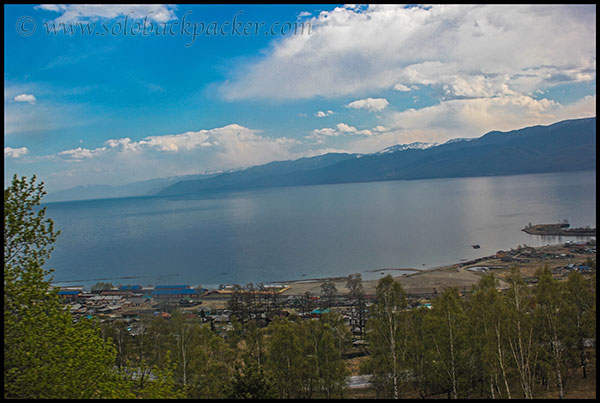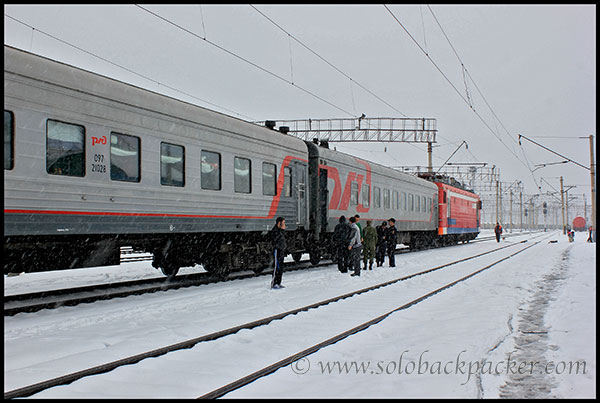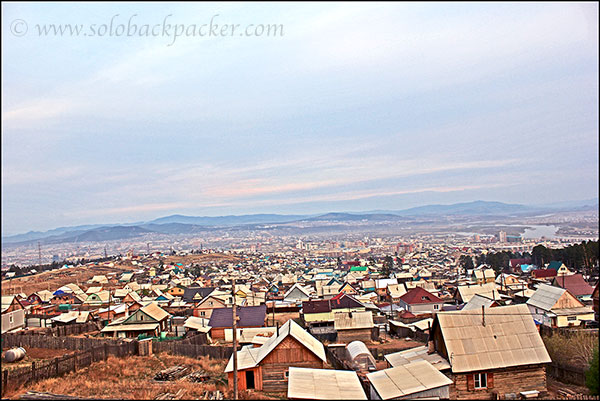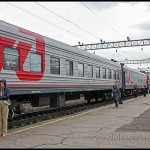The Trans-Siberian Rail Journey is unarguably one of the most exciting train journey in the world. It starts from the Russian capital Moscow, crosses natural landmarks like the Volga River and the Ural Mountains, passes through a pillar post marking the border of Europe and Asia, runs through the magnificent plains of the Steppes, through the dense Taiga forests, along the shores of the world’s largest freshwater lake The Baikal and after crossing 7-time zones, ends in the Far-East corner at Vladivostok, the San Francisco of The East. In winters, entire landscape covered by the white snow in Siberia makes it a lifetime ride to the fairy land.
It was one of my long-cherished dream to complete a journey on the Trans-Siberian Railway. Finally, the dream was fulfilled this year to give me some great experiences and everlasting memories of the Trans-Siberian journey in Russia. Here, I am trying to provide all the relevant information in four separate posts, so that you can also plan an independent trip on the Trans-Siberian Railway. I didn’t travel on Trans-Manchurian as well as on Trans-Mongolian Line, so my details are limited to the classical Trans-Siberian Line from Moscow (or you can say from Saint Petersburg) to Vladivostok. To get the maximum benefit of this trip guide, it’s advisable to go through all the four posts one by one.

The Trans-Siberian Railway, The most common myth: Trans-Siberian Railway, the name itself is a myth for many people. Many people think that The Trans-Siberian Railway is a particular train (say, Trans-Siberian Express), that runs from Vladivostok to Moscow ( or to Leningrad). But in reality, it is not a particular train. The Trans-Siberian Railway is a name given to the railway network of Russia, that spreads across the Siberia from Moscow to Vladivostok. On this railway network not a single, but many long-distance trains operate everyday including the passenger trains as well as the goods trains.
Beyond Moscow, this railway network further expands in North-West direction towards Leningrad (Modern Saint Petersburg), that is why our books say that Trans-Siberian Railway runs from Leningrad to Vladivostok. But, in reality, there is not a single train that operates directly from Leningrad to Vladivostok. However, there are few trains operating from Moscow to Vladivostok directly. To complete the entire journey from Leningrad to Vladivostok, you have to first travel on a train from Leningrad to Moscow and then, by another train from Moscow to Vladivostok. That is why many people believe that the Trans-Siberian Railway starts from Moscow, not from Leningrad.

Routes of the Trans-Siberian Railway Network: Across the vast expanses of Siberia, the Trans-Siberian Railway Network has many routes, but from a tourist point of view, three routes are important :
1. Classical Trans-Siberian Route: Traditional Route (Moscow to Vladivostok)
This is the traditional Trans-Siberian Railway line that runs from Moscow to Vladivostok since 1916 and still expanding. The complete 9288 kms distance from Moscow to Vladivostok can be covered by a single train in 7-8 days after crossing 7-time zones and if you plan to stop en-route, it may take many more days.
Visa Requirements for this route: The entire route lies in the Russian Federation, so you need a tourist visa only for Russian Federation to travel on the classical Trans-Siberian Route.
2. Trans-Manchurian Route: Classical Trans-Siberian Route upto Chita (Moscow-Chita) + Chinese Railway Route in China
It follows the classical Trans-Siberian Railway Route from Moscow to Chita, then branched-off from the traditional route at Tarskaya (near Chita) and enter in China via Harbin and proceeds further to Beijing. Another section of this line also proceeds to Pyongyang in North Korea.
Visa Requirements for this route: The prior visa is required for Russian Federation as well as for China to travel from Moscow to Beijing or vice-versa on this route.
3. Trans-Mongolian Route: Classical Trans-Siberian upto Ulan Ude (Moscow-Ulan Ude) + Mongolian Railway Network + Chinese Railway Network
It follows the classical Trans-Siberian Railway Route from Moscow to Ulan Ude. Then a line heads Southwards to Mongolia and then further towards China. Majority of the tourists follow this route to travel between Moscow and Beijing.
Visa Requirements for this route: The prior visa is required for Russian Federation, Mongolia and China, all three countries.
Another Important Route, Baikal-Amur Mainline (BAM): The Trans-Siberian Railway network in Siberia runs very close to the Chinese Border, thus making it highly vulnerable in the sections close to the Chinese Border. To gain some strategic advantages, Russians built another railway line across Siberia in further north direction to the classical Trans-Siberian Line. This railway line, popularly known as Baikal-Amur Mainline (BAM) departs from the Trans-Siberian railway at Tayshet, then crosses the Angara River at Bratsk, proceeds past Severobaikalsk at the northern tip of Lake Baikal, past Tynda and Khani finally reaches the Pacific Ocean at Sovetskaya Gavan.

Which Route Should You Use? Any, depending on your choices and visa status. If you have sufficient time and proper visas, you can travel on Moscow-Vladivostok classical route, then come back to Chita, follow Trans-Manchurian route to Beijing and then return to Moscow on Trans-Mongolian Route. It will take at least one month for the complete journey at comfortable pace.
The most popular route among the tourists is the Trans-Mongolian Line. It provides a perfect opportunity to explore the beautiful destinations in Russia, in Mongolia as well as in China.
Eastwards or Westwards, Which direction should you follow? Again your own convenience. It doesn’t matter at all. I started from Vladivostok, because its my style of travel. I generally go to the farthest end of my trip asap in the beginning and then slowly move towards the departure airport to spend the last days of a trip.
Planning En-Route Stops: Normally, a train takes about 7-8 days to complete the journey from Moscow to Vladivostok. If you go straight for this 7 days journey in one go, you may feel bore after 4-5 continuous days in the train. Continuously travelling in a train for 4-5 days is also very exhausting. It’s a good idea to explore some en-route destinations, while travelling on this route. Lot of beautiful destinations are available to enjoy on this route, where you can spend your time comfortably. Some diehard travellers do complete the entire stretch in one go. But in my opinion, breaking the journey and planning some en-route destinations is the thing, that you should always consider on this route.
However, you just can’t get off from the train at the choice of your destination to get on again using the same ticket. You have to plan the different sections of your trip carefully with different reserved tickets. Some beautiful destinations on this route are:
1. Yaketerinburg: The capital of the Ural region has an impressive collection of Soviet-period buildings and interesting museums showcasing local crafts, arts, and nature.
2. Irktusk: The most popular stop to visit the famous Lake Baikal, the largest freshwater lake in the world and a UNESCO World Heritage Site. The city itself offers traditional Siberian ornamented wooden houses, an icebreaker, a dam and of course several churches and museums dedicated to the culture and history of the region.
3. Ulan Ude: Near the border of Mongolia, it has the biggest Buddhist monastery in Russia. This beautiful city also features the biggest Lenin’s head (a prominent statue in most of the Russian cities) in the world.

Other important destinations on this railway route are Nizhny Novgorod, Perm, Novosibirsk, Chita and Khabarovsk. While travelling from Moscow to Novosibirsk, maximum trains pass via Vladimir, Nizhny Novgorod, while few others via Yaroslavl. If you plan to explore the cities like Perm, Nizhny Novgorod, then choose your train carefully. After deciding your en-route destinations, you can plan your night stops as well as the connecting trains between those cities.
Should you travel independently? Yes, to get that ultimate sense of adventure, plan your trip independently. It required a bit hard work, planning, research for booking the train tickets, planning the stop-overs, booking the hotels etc, but this adventure is worth the every efforts. It also helps you to travel at your own comfortable pace.
Is it safe? The train journey on Trans-Siberian network is perfectly safe. Most of the Russian women and young girls travel alone on these trains everyday. So why not you? Don’t worry too much about the safety. Exercise some basic precautions as you take anywhere else and enjoy your journey. Russians are very nice and caring people, at least for a solo Indian traveller like me.
In the next post, I will try to provide some information about the type of trains, coaches and berths. It will help you to make a good choice while booking the tickets.








am going in June 16. Had a few misconceptions which got cleared after reading your post. Thank you.
That’s really awesome. Have a great journey. Looking forward to hear your experiences. 🙂
Hey Solobackpacker, what is the best thing to do if i were to go to russian for 2-3week. Should i go by mongolia route or trans-siberian route? what is the 1 thing i must go or visit in Russia and i can plan my trip around there?
Thanking you in adv.!
If you ask for one thing only, then it would be Trans-Siberian Railway Journey for sure. Baikal lake is also a big attraction. If you can do via China and Mongolia, then that’s always a better option. I wasn’t interested to deal with the visa of China and Mongolia, so did only in the Russia. For 3 weeks, plan your journey on Trans-Siberian and then stay on the way in some cities like Ulan Ude, Irkutsk, Yaketerinberg, Kazan, Perm, Moscow etc. That will be an ultimate adventure. Have a nice trip. Do share your experiences. 🙂
Hi mate,
what part of the year did you travel to Russia ?
Hi, I went there in May, 2015. 🙂
waiting for the next part..
Eagerly waiting for the next part
This is definitely a ‘once in a life time ride’.